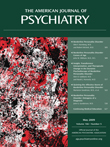Psychopathology During Childhood and Adolescence Predicts Delusional-Like Experiences in Adults: A 21-Year Birth Cohort Study
Abstract
Objective: Community surveys have shown that many otherwise well individuals report delusional-like experiences. The authors examined psychopathology during childhood and adolescence as a predictor of delusional-like experiences in young adulthood. Method: The authors analyzed prospective data from the Mater-University of Queensland Study of Pregnancy, a birth cohort of 3,617 young adults born between 1981 and 1983. Psychopathology was measured at ages 5 and 14 using the Child Behavior Checklist (CBCL) and at age 14 using the Youth Self-Report (YSR). Delusional-like experiences were measured at age 21 using the Peters Delusional Inventory. The association between childhood and adolescent symptoms and later delusional-like experiences was examined using logistic regression. Results: High CBCL scores at ages 5 and 14 predicted high levels of delusional-like experiences at age 21 (odds ratios for the highest versus the other quartiles combined were 1.25 and 1.85, respectively). Those with YSR scores in the highest quartile at age 14 were nearly four times as likely to have high levels of delusional-like experiences at age 21 (odds ratio=3.71). Adolescent-onset psychopathology and continuous psychopathology through both childhood and adolescence strongly predicted delusional-like experiences at age 21. Hallucinations at age 14 were significantly associated with delusional-like experiences at age 21. The general pattern of associations persisted when adjusted for previous drug use or the presence of nonaffective psychoses at age 21. Conclusion: Psychopathology during childhood and adolescence predicts adult delusional-like experiences. Understanding the biological and psychosocial factors that influence this developmental trajectory may provide clues to the pathogenesis of psychotic-like experiences.



